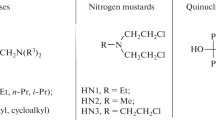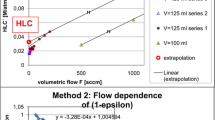Summary
There exist at least two surveys (Yajima 1964 [4] andNeumann 1969 [5]) on the state of the technique of water determination by gas chromatography. In a critical evaluation of the more recent survey, unexplained systematic sources of error are pointed out. The technique of GC joins the Karl Fischer titration and electrochemical trace determination methods as an efficient and competitive method. Using carbon molecular sieve as an adsorbent, water can be determined in gases (down to 20 weight-ppm) and in liquids or fusible solids (down to 0.2 weight-ppm) in less than 60 seconds. On carbon molecular sieve, water is eluted before even methane.
When converting traces of water into acetylene, a procedure that can be carried out with little error in continuously flowing systems, and using the method of reversion chromatography (RVGC) [8], H2O can be determined, preferably in gases, but under certain conditions also in liquids and solids, in concentrations as low as 10−9 weight-percent, corresponding to 10−2 weight-ppb. Such a method requires a continuous sample flow, which has been recognized as an indispensable condition for ultra-trace analyses of polar compounds. However, such ultra-trace analyses can be carried out fully automatically by the technique of RVGC.
So as to keep the error as low as possible when determining water in the percent range, it is necessary to use correction factors which must always be freshly determined for the individual samples. They depend strongly on the concentration, the condition of the detector, and the state of the GC instrument, as well as on the mobile phase.
It was found that quartz is the most suitable materials for walls and ducts for quantitative water determinations. The time taken by the transfer of water from the water film on a glass or metal surface into rigorously dried gas, and the speed with which dry solvents become moist in normal laboratory atmosphere, indicate the special problems of quantitative water determination by gas chromatography and point the way to a correct working technique.
Zusammenfassung
Über den Stand der Technik bei Wasserbestimmungen durch Gas-Chromatographie liegen mindestens zwei Übersichtsarbeiten vor (Yajima 1964 [4] undNeumann 1969 [5]). In einer kritischen Auswertung der neueren Übersichtsarbeit wird auf ungeklärte systematische Fehlerquellen hingewiesen. Die GC-Technik tritt als leistungsstarke Konkurrenzmethode an die Seite der Karl-Fischer-Titration und der elektrochemischen H2O-Spurenbestimmungsmethoden. Mit Kohlenstoffmolekularsieb als Sorptionsmittel läßt sich Wasser in Gasen (bis 20 Gew.-ppm) und in flüssigen oder schmelzbaren festen Stoffen (bis 0,2 Gew.-ppm) in weniger als 60 Sekunden bestimmen. Wasser wird auf Kohlenstoffmolekularsieb noch vor Methan eluiert.
Wandelt man Spuren von Wasser in Acetylen um, was im stetig strömenden System fehlerarm möglich ist, und wendet die Methode der Reversions-Chromatographie (RVGC) [8] an, dann läßt sich H2O vorzugsweise in Gasen, auf Umwegen auch in Flüssigkeiten und festen Stoffen, in Konzentrationen bis günstigstenfalls 10−9 Gew.%, entsprechend 10−2 Gew.-ppb, bestimmen. Eine solche Methode erfordert die kontinuierliche Probenzufuhr, die als unabdingbare Voraussetzung für Ultraspurenanalysen polarer Stoffe erkannt wurde. Solche Ultraspurenbestimmungen laufen aber mit der RVGC-Technik vollautomatisch ab.
Zur fehlerarmen Wasserbestimmung im %-Bereich sind stets frisch und individuell bestimmte Korrekturfaktoren notwendig. Sie sind stark von der Konzentration, dem Betriebszustand des Detektors und dem gerade herrschenden Zustand des GC-Gerätes sowie der mobilen Phaseabhängig. Als am besten geeignetes Wand- und Leitungsmaterial für quantitative Wasserbestimmungen hat sich Quarz erwiesen.
Quantitative Angaben über den Zeitverlauf beim Übergang von Wasser aus der Wasserhaut einer Glas- oder Metalloberfläche in hochtrockenes Gas und über die Geschwindigkeit, mit der sich trockene Lösemittel an normaler Laborluft befeuchten, erklären die besondere Problematik der quantitativen Wasserbestimmung durch Gas-Chromatographie und verweisen auf die richtige Arbeitstechnik.
Sommaire
Il existe au moins deux travaux (Yajima 1964 [4] etNeumann 1969 [5]) qui donnent une vue d'ensemble sur l'état actuel de la technique de détermination d'eau par chromatographie en phase gazeuse. Dans une évaluation critique du travail plus récent, on indique des sources d'erreurs systématiques qui ne sont pas expliquées. La technique de CG, en tant que méthode efficace et compétitive, va joindre les méthodes de titration d'après Karl Fischer et de détermination, par voie électro-chimique, de traces de H2O. En utilisant du tamis moléculaire de carbone comme adsorbant, l'eau peut être déterminée en moins de 60 secondes dans des gaz (jusqu'à 20 ppm du poids) et dans des liquides ou solides fusibles (jusqu'à 0,2 ppm du poids). Sur tamis moléculaire de carbone, l'eau est éluéc encore avant le méthane.
Si l'on convertit des traces d'eau en acétyléne, ce qui est possible avec peu d'erreur dans des systèmes à courant continu, utilisant ensuite la méthode de la chromatographic de réversion (RVGC) [8], on peut déterminer le H2O surtout dans des gaz, mais sous certaines conditions aussi dans des liquides et solides, pour des concentrations continue en échantillon, qui a été reconnue comme condition indispensable pour l'analyse de traces infimes de substances polaires. Cependant, de telles analyses de traces infimes se développent tout à fait automatiquement avec la technique de RVGC.
Afin de déterminer l'eau avec un minimum d'erreur dans la région des %, il faut employer des facteurs de correction déterminés de nouveau pour chaque échantillon individuel. Ils dépendent fortement de la concentration, de la condition du détecteur et de l'état général du chromatographe en phase gazeuse, ainsi que de la phase mobile.
Le matériel le mieux adapté pour servir de paroi dans les déterminations d'eau est le quartz.
Des indications quantitatives sur le temps pris par l'eau pour passer du film d'eau sur une surface de verre ou de métal à du gaz sec, et sur la vitesse avec laquelle des solvants secs deviennent humides dans une atmosphère de laboratoire normale, expliquent les problèmes particuliers posés par la détermination quantitative de l'eau par chromatographie en phase gazeuse; la technique correcte de travail est également indiquée.
Similar content being viewed by others
Literatur
Eberius, E., Wasserbestimmung mit Karl-Fischer-Lösung, Monographie, Verlag Chemie, Weinheim 1954.
Taylor, E. S., Refrig. Engng.64, 41 (1956).
Crawshaw, J. K., Davidson, F. G., J. of Sci. Instr.36, 121 (1959).
Yajima, S., Kagaku no Ryoiki18, 901 (1964); Chem. Abstr.64, [2], 2722 (1966).
Neumann, G. M., Z. analyt. Chem.244, 302 (1969).
Deans, D. R., Chromatographia1, 18 (1968).
Goldup, A., Westaway, M. T., Analytic. Chem.,38, 1657 (1966).
Kaiser, R., Chromatographia1, 199 (1968).
Kaiser, R., Chromatographic in der Gasphase, Bibliographisches Institut Mannheim, Hochschultaschenbuch 92/92a, 2. Auflage, S. 122 (1969).
Author information
Authors and Affiliations
Rights and permissions
About this article
Cite this article
Kaiser, R. Wasserbestimmung bis 10−9 Gew.-%. Chromatographia 2, 453–461 (1969). https://doi.org/10.1007/BF02260354
Received:
Accepted:
Issue Date:
DOI: https://doi.org/10.1007/BF02260354




